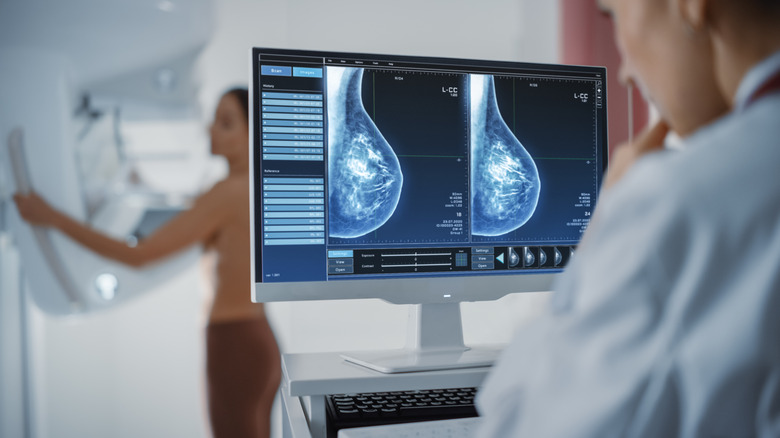Is Burning Pain In Your Breast A Sign Of Breast Cancer?
Breast cancer occurs in different parts of the breast, including the milk ducts (via Mayo Clinic). It's the most common cancer among women worldwide, and it can affect people of any age. However, it's more common in women over 50 years old, per the Centers for Disease Control and Prevention (CDC).
Certain lifestyle factors can increase the risk of breast cancer. Obesity, lack of physical activity, and alcohol consumption may create increased risk. In addition, certain genetic mutations, such as those in the BRCA1 and BRCA2 genes, can increase the risk of breast cancer, says the CDC.
If you are experiencing any changes in your breasts or have concerns about breast cancer, it is important to speak with a doctor for a proper diagnosis and treatment plan. It's also important to speak about the risk factors for breast cancer and to undergo regular screenings. Early detection and treatment are important for improving the outcome of breast cancer.
Is burning pain a symptom of breast cancer?
According to Medical News Today, breast cancer is normally painless. However, it is possible for feelings of tenderness to occur, since the condition causes changes in the breast cells. Some people with breast cancer may experience breast pain, particularly if the cancer has spread to the chest wall or the skin of the breast, according to the Cancer Treatments Centers of America.
Typical breast cancer symptoms include a lump or thickening in the breast or underarm and changes to the nipple, such as flaking and discharge (via the Cancer Treatments Societies of America). According to the source, changes in the size or shape of the breast can also occur. The breast may look red and feel swollen, with one breast looking larger or heavier than the other. The skin may look dimpled, puckered, or red and the nipple may be pulled inward or look different.
How is breast cancer diagnosed?
Several screening tests can be used to detect breast cancer. Mammography, for example, is a low-dose X-ray of the breast that can detect early signs of abnormalities (per Cleveland Clinic). This testing method can be used to screen for breast cancer in women who have no symptoms, says the clinic. Ultrasound, on the other hand, uses sound waves to create a picture of the inside of the breast. It can be used to help diagnose breast lumps or other abnormalities, per Mayo Clinic.
Breast magnetic resonance imaging (MRI) is another diagnostic method that uses a strong magnetic field and radio waves to create detailed images of the inside of the breast. Lastly, a breast biopsy can also be used to confirm a diagnosis of breast cancer. In this procedure, a small sample of breast tissue is removed and examined under a microscope to determine if it is cancerous.
If breast cancer is suspected based on the results of a screening test, a healthcare provider may recommend further testing to confirm the diagnosis. It is important to work with a healthcare provider to develop a treatment plan if breast cancer is diagnosed.



